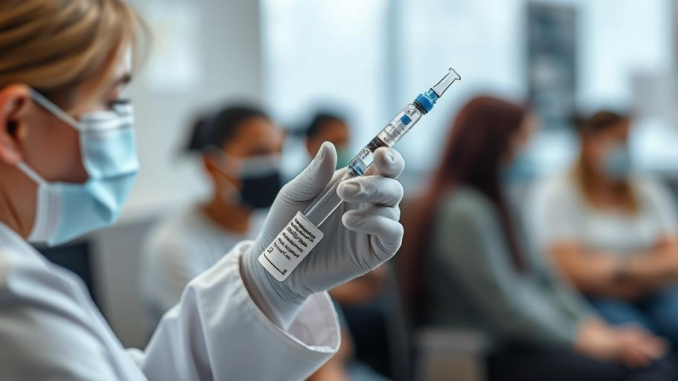
Summary
This article discusses the concerning decline in childhood vaccination rates following the COVID-19 pandemic. Several factors contribute to this decline, including disruptions in healthcare access, misinformation, and vaccine hesitancy. The article explores the potential consequences of lower vaccination rates and highlights strategies to improve vaccine uptake.
Healthcare data growth can be overwhelming scale effortlessly with TrueNAS by Esdebe.
** Main Story**
Okay, so, we really need to talk about childhood vaccination rates. It’s a bit of a mess, honestly. The pandemic threw everything off, didn’t it? Suddenly, the world was laser-focused on COVID-19, and routine childhood vaccinations took a nosedive. And the thing is, they haven’t really bounced back to where they were before, which is kinda scary.
It’s not just a little dip; this is a potential public health crisis brewing. We’re talking about a real risk of outbreaks of diseases we thought we’d mostly gotten rid of. So, what’s going on, and what can we do about it? That is the million dollar question, isn’t it?
Understanding the Dip: It’s Complicated
Honestly, there isn’t just one reason why vaccination rates are so low; it’s a whole cocktail of problems. First off, the pandemic messed with everything. Lockdowns meant people couldn’t get to the doctor as easily, and healthcare systems were, you know, a little busy dealing with other things. Even routine check-ups became difficult.
Then, school closures didn’t help. Parents might have thought, ‘Well, if my kid isn’t in school, they aren’t as likely to get sick anyway, right?’ Wrong. But there was also this feeling of like a decreased urgency which is never a good thing when talking about preventative medicine.
But beyond the practical issues, there’s the whole misinformation angle. Social media became a breeding ground for all sorts of nonsense about vaccines causing autism and other stuff. And it’s all complete bunk, obviously, but it still scares people. This “infodemic,” as some people call it, has fueled parental fears and made people hesitant, and it’s hard to fight against. Plus, it feels like there’s this growing distrust in public health institutions and government in general and honestly I think that is only going to get worse.
The Price of Low Vaccination Rates: Diseases Coming Back
When vaccination rates drop, things get dangerous really quickly. You know about herd immunity, right? It’s where enough people are vaccinated to protect the whole community, including those who can’t get vaccinated like infants or people with certain health conditions. If we fall below that threshold, things go sideways.
We’ve already seen measles cases popping up again, and that should be a major wake-up call. And it isn’t just measles. Diseases like whooping cough and even polio, which we’d mostly wiped out, could make a comeback. I remember a story from when I volunteered at a health clinic, a little girl contracted whooping cough, her parents hadn’t vaccinated her. It took her weeks to recover, and the stress it put on the family was just awful.
What We Need To Do: A Plan of Action
Alright, so what do we do? Well, there isn’t a one size fits all answer, its going to take a multifaceted approach.
-
Improving Access and Education
Healthcare providers, they’re on the front lines here. And have to be ready to clearly communicate, listen to people’s concerns, and correct the misinformation that is unfortunately, now commonplace. It’s not about lecturing people; it’s about having a conversation. Practices should also make it as easy as possible for people to get vaccinated. Things like reminder systems, flexible appointments, integrating vaccinations into regular checkups, all that helps. If people dont know they need to get vaccinated, they wont get vaccinated. Centralized reminder systems can really help.
-
Tackling Misinformation
Public health campaigns need to be really aggressive in fighting misinformation. Give the facts; show the data. Partner with trusted community leaders, because people are more likely to listen to someone they trust. Social media platforms, they need to step up too. They can’t just let the misinformation spread like wildfire; they need to take responsibility and actively promote credible sources of information.
-
Policy and School-Based Interventions
Stronger school vaccination requirements can help. Limiting those non-medical exemptions, where people opt out for personal beliefs, could also boost vaccination rates. School-based vaccination programs, you know, bringing the vaccines to where the kids are, can make a big difference, especially for underserved communities. I read about how Australia uses financial incentives, too; that might work for some people, especially if it’s combined with efforts to address their concerns. Because lets face it, money talks and if you can get a bonus to keep you and your family safe, why wouldn’t you?
Look, this isn’t some abstract problem, right? This is about protecting kids from diseases that can cause real harm. It’s about safeguarding the health of our communities. We all have a role to play. As of today, April 6, 2025, this information is the best we have, but public health is like the weather; it changes all the time, so we’ve gotta keep our eyes open and adjust as needed.


The discussion highlights the role of healthcare providers. What strategies could be implemented to better equip healthcare professionals in addressing vaccine hesitancy and effectively communicating the benefits of vaccination to diverse populations?